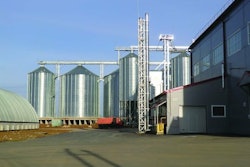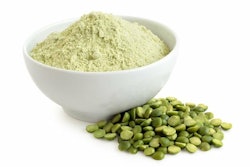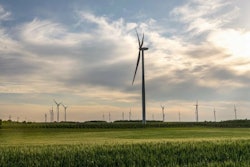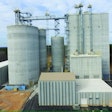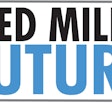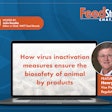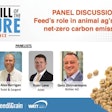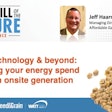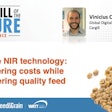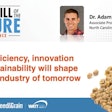Cargill Animal Nutrition’s president Adriano Marcon explores the technologies set to elevate feed production, animal nutrition
As macro trends influence change and new technologies are introduced, animal feed production and formulation will further evolve as well. In some areas, this growth has been accelerated.
Cargill’s Adriano Marcon joins the Chat to explore concepts shaping feed production efficiency and the new technologies optimizing feed manufacturing and animal nutrition.
Transcription of Feed Strategy Chat with Adriano Marcon, president, Cargill’s animal nutrition business
Jackie Roembke, editor in chief, WATT Feed Brands/Feed Strategy:Hi, everyone. Welcome to Feed Strategy Chat. I’m your host, Jackie Roembke, editor in chief of WATT Feed Brands and Feed Strategy magazine.
This edition of Feed Strategy Chat is brought to you by WATT Global Media and FeedStrategy.com. FeedStrategy.com is your source for the latest news and leading-edge analysis of the global animal feed industry.
Today we’re joined on Zoom by Adriano Marcon, the president ofCargill animal nutrition业务。他在这里讨论宏观趋势的关键s impacting the feed industry and how these may impact the evolution of the production. Hi Adriano, how are you today?
Adriano Marcon, president, Cargill animal nutrition:Hi, Jackie, it’s great to be with you today.
Roembke:Thank you so much for your time. Well, let’s get right into it.Consolidation has been a hot topic for well over a decade now. How do you expect feed industry consolidation among both suppliers and manufacturers to impact feed production in the future?
Marcon:So Jackie, that’s an inevitable trend. As it happens in so many industries, consolidation will continue to happen our feed industry. We have to remember this is a still very fragmented industry; there’s 29,000 feed mills in the world. And if you see the top 130 companies, they produce 39% of the world’s feed. That’s very, very fragmented relative to many other industries.
So consolidation will continue to happen. And I think it actually helps to advance the standards of the industry.
Roembke:All industries are feeling increased pressure to address climate change concerns by embracing and investing in new technologies and sustainable practices. What does the feed industry need to do? Or what can it improve upon to become a more sustainably conscious supply chain partner?
Marcon:First of all, here at Cargill, we believe agriculture is the solution to many challenges that we’re facing today. Oftentimes, we are in a very defensive position, but it’s important to provide context. We have been doing a lot over the last decades, evolving efficiency is critical to the survival of the industry.
So think about the milk production the U.S. We’re producing the same gallon of milk with almost 50% of the resource in terms of feed resources, number of cows, etc., than we needed 30, 40 years ago. So that’s an incredible contribution to sustainability.
The same goes to the poultry industry, to the swine industry. Animals are being produced in a much more efficient fashion, less feed needs to the same pound of meat and grow faster as well. So less space is needed. So we’re doing a lot now.
We understand that livestock production is responsible for 14% — give or take — of the human-originated greenhouse gases. So we want to do more. We believe that by uncovering the power of farmers and nutrition, we will be able to do more with less. And that what we want is to meet that noble juncture of truly feeding the world and protecting the planet. We don’t believe it’s an either/or game, it has to be an end game. There’s a lot of people that have challenges with food accessibility, food inflation is real. So we feed the world — and we have to feed the world.
Also for that 1 billion people that can’t eat properly every day, that should not be incongruent to protecting the planet. We will continue to evolve our productivity standards and as we do this, we want to contribute to global cooling, not global warming. We want to change the narrative by doing even more by applying more innovation, by helping livestock producers do their part in a much stronger fashion.
Roembke: So what leading edge technologies is Cargill Animal Nutrition investigating or investing in to reduce its environmental footprint?
Marcon:Well, Jackie, I think first it is safe to say that the feed mill of the future is safe. It’s more safe. It’s data driven. Probably is going to have fewer people. But it’s also going to be able to capture waste streams optimizing every bit of returns from the mill while it’s still increasing throughput and capacity. But first and foremost, the feed mill of the future is going to be focused on what the animal needs.
And, for example, in swine, I’ll give you an example of particle size. If you have the wrong particle size, that can impact your feed conversion from 5% to 10%. That means grinding properly, designing to grind properly, which is very basic, can influence significantly the efficiency of that animal and the health of that animal.
In broilers, conversely, every 10% of fines in a pelleted feed can improve almost a percentage point in feed conversion. The other way to think about it is that every 2% of fine that a better feed plant can reduce, because it’s better designed or because has better process controls, can allow to lower the diet energy by 25 kilo calories per ton. Right, that saves feed ingredients as well. So we’re designing for animal needs. It’s what’s front and center for us.
In terms of the focus for us in technology, we at Cargill Animal Nutrition, we are targeting zero nutrient waste. As we think about that we strive to deliver solutions that are addressing actually both sustainability and productivity challenges for customers. We know that feed processing can help to make nutrients more available to the animal, and therefore can contribute to the sustainability costs. Again, so if we do a better job on pelleting or cooling or extrusion, we will be able to unlock more nutrients. And that will cause animals to be healthier and to be more productive as well.
So as we think about innovation, the animal welfare, the animal productivity is key for us. Now, if I zoom in a little bit to the premix industry, that’s a different game, right? I mean, what we want there is incredible rigor, multiple data checkpoints, ultimate safety procedures. In a plant like that, we have an incredible high inventory of a whole bunch of micro ingredients, that all look like a white powder — so we can’t pick the wrong one. Mixing qualities is super important. Micro-dosing, that means those in parts per million, and that accuracy is fundamental, we cannot allow for any cross contamination. A premix plant is much, much more sophisticated in terms of use of sensors, you use the error-proof mechanisms, then it was like 10 years ago, let alone 35 years ago, right?
Lots of innovation in that space. And we’re learning every new plant. I mean, our our flagship plant now that we opened in Ohio in the United States a year ago has taught us that there’s so many new technologies that we’re developing here and applying to other plants in the world. So lots of innovation there, but again, focusing on the animal first.
Roembke: And in the feed mills specifically, have any energy-efficiency related investments taken place or planning for regulations in the future? How does that translate in the mill?
Marcon:That’s a very interesting question because we may have conflicting targets here. So the answer is yes. We want much more energy-efficient plants, we’re looking at using more alternative energy sources like solar, for example, right? That’s our day-to-day effort here. We also are replacing, for example, engines with much more efficient engines, more environmentally friendly engines. But here’s the deal. I mean, if I want to grind the ingredients finer because my focus No. 1 is animal performance, that’s gonna consume more energy. And that’s all right, because the impact on saving 5% to 10% of the ingredients I need to produce the same amount of poultry meat or pork, it’s much more impactful than the energy increase I’m going to have at the plant, at the feed mill.
我们首先把动物和动物效率冷杉t and animal welfare first. At the same time, we try to build more efficient plants. Way to look at is, Jackie, is in terms of plant innovation. We’re advancing the use of artificial intelligence, our search is zero nutrient waste, we want to extract everything that ingredients like corn or soybean meal can offer to animals. And this is not a given and there’s a lot of nutrients that animals can’t absorb. So one of the things we’re doing differently today is by using smart manufacturing capabilities and artificial intelligence to extract more of the nutrients.
So we have a solution calledMAX NIRwhich is basically an in-line NIR in feed plants. So these probes they are measuring the variability of, for example, protein in soybean meal in real time. So if the soybean meal that we are receiving has a higher protein content so these sensor will send a signal to the feed plant that’s going to auto-reformulate the feed so that that next batch is going to take advantage of the higher protein content of the soybean meal that the plant received.
So zero nutrient waste maximum use of the ingredients were receiving, that also is going to be the future and the job of feed plants.
Roembke:Very good.You mentioned AI, can you describe how AI and other emerging IoT technologies can be leveraged to improve the production and efficiency today?
Marcon:If you allow me to depart a little bit from feed plants, I definitely can. I mean, we recently launched two innovations we’re very, very proud of. The first one is what we callGalleon. Galleon is a microbiome assessment tool that truly uses artificial intelligence modeling. So what Galleon does, it enables by taking swabs of birds in the barn so it reads the profile of bacteria to the DNA level. With that, we compare the standards of the farm with standard stuff, a microbiome of a farm that is very healthy, very productive. So, producers can now decide how, for example, changes in raw materials in diets and additives in vaccine programs — or even farm management practices — can influence the microbiome, and how far apart their own microbiome at the particular time is from what could be ideal for productivity.
So you have this information. Now, you no longer need to trust in anecdotal evidence to make a change on a probiotic program, or on a farm management practice or on a vaccine program. We use that information to help to modulate your microbiome for optimal gut health and optimal animal health. That’s all based in artificial intelligence, right? This project started like 12 years ago. And the amount of samples they used to detect those patterns and compare and discern was incredible, it’s comparable to the human genome when that project started. So we’re very proud that I think Galleon, that technology is going to be a game changer for the poultry industry. That’s No. 1.
The second one we recently announced as well. It’s a partnership with an Indian developer that created a solution that we’re namingBirdoo. Birdoo is the first-of-its-kind of technology that leverages computer visioning in artificial intelligence as well. It combines hands-free, real-time flocking sites with predictive modeling data. What Birdoo is doing, these cameras are reading the weight of the birds in the farm, and with that, they follow real time the growth curve. So if the growth growth curve, again, deviates from what we expect as the ideal growth curve, that’s an incredible information for animal nutritionists or farm managers to take corrective measures. Today, companies either way, use manually or use on farms, scales that have accuracy problems, accuracy challenges, so Birdoo is kind of solving that problem.
Roembke:Excellent. Thank you so much for sharing your insights. If you would like more information on the feed industry in the years ahead, please visitwww.feedstrategy.com/feed-mill-of-the-futureto subscribe to our digital supplements, or to peruse all the content we have there. Thank you so much, Adriano, and thanks to you for tuning in.
Marcon:Thanks for having me, Jackie.
Announcing the Feed Mill of the Future digital supplement
WATT’s feed brands Feed Strategy and Feed & Grain magazines join forces to launch the monthly Feed Mill of the Future digital supplement. Each edition aims to provide animal feed industry stakeholders with forward-looking content, market insights and a spotlight on the leading-edge technologies shaping the global feed industry of tomorrow.
Subscribe today!https://bit.ly/3dWzow7





